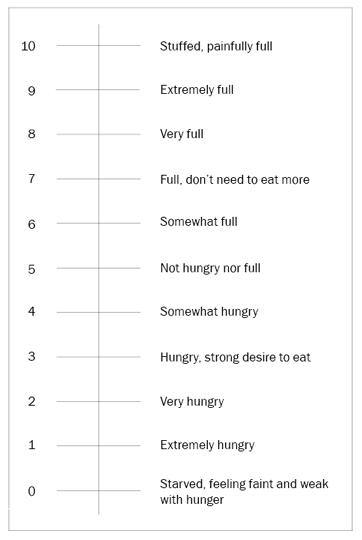Mindful Eating
 Mindful eating is eating with awareness, and involves paying attention to your body’s signals. This means allowing yourself to eat when you are hungry and knowing to stop when you are full. Mindful eating is good for your well-being because it can help you eat in a healthy, balanced way.
Mindful eating is eating with awareness, and involves paying attention to your body’s signals. This means allowing yourself to eat when you are hungry and knowing to stop when you are full. Mindful eating is good for your well-being because it can help you eat in a healthy, balanced way.
What are the key things you need to know to practice mindful eating?
- Listen to two important body cues: hunger and fullness
- Notice feelings or situations when you eat for reasons other than hunger
- Use your senses to pay attention to how your food looks, smells, and tastes
- Focus on food as fuel for your body
What is “mindless eating”?
Mindless eating is the opposite of mindful eating. It’s eating in response to something other than hunger. Mindless eating means not paying attention to your body’s hunger and fullness signals.
There are lots of reasons you might eat mindlessly. For example:
- You feel sad, mad, tired, bored, and/or lonely. You treat yourself to a large dessert to make yourself feel better.
- You see or smell a food that looks really tempting. You’re full from dinner but get a large tub of popcorn at the movies because it smells so good.
- You’re used to eating at certain times, even though you’re not necessarily hungry at those times. You eat lunch at 12pm because it’s “lunch time” even though you aren’t really hungry for lunch because you had a late breakfast.
- You’re doing something else while eating. You snack while watching TV and lose track of how much you ate or how it even tasted.
How am I supposed to know exactly how hungry I am?
If you have a hard time knowing just how hungry you are, the hunger and fullness scale can be a great tool to help you figure this out. Use this scale to stay in touch with your body’s signals and to guide your food and portion choices. When using the hunger and fullness scale, try to stay between 3 and 7. This will prevent you from feeling too hungry or too full.

How can I learn how to eat mindfully?
There are things you can do before, during, and after you have a meal or snack that will help you eat more mindfully. Start off slow. This may be a big change for you. Start practicing these steps at one meal and then work your way up to eating mindfully every time you have a meal or snack.
Before you eat:
1. Ask yourself, am I really hungry?
- Listen to your body cues. Physical signs that you are hungry include “growling” and/or hunger pangs in your stomach, lightheadedness, a hard time staying focused, and/or feeling cranky.
- If you’re craving food because you are feeling stressed, try going for a walk with a friend, taking a yoga class, or playing sports in order to help lower stress.
- If you’re eating just because the food is there, or because you’re bored, do something that you enjoy such as riding a bike or listening to music instead.
2. Choose foods that will satisfy your hunger.
- If you’re hungry, a filling meal that includes whole grains, fruits and vegetables, lean protein (fish, chicken, turkey, tofu, beans) and heart-healthy fats (olive oil, almond butter) can be very satisfying when eaten together. Avoid skipping meals. Omitting meals or snacks when you are hungry may lead to overeating later in the day.
- If you’re a little hungry, a snack might be the best way to satisfy your appetite. Lean protein (low-fat cheese, low-fat yogurt, and hummus) paired with fruit, vegetables and/or whole grains (whole wheat English muffin or whole grain crackers) can help to fill you up until your next meal. Here are some healthy snack ideas.
While You Eat:
1. Get rid of distractions.
- Enjoy the meal or snack without the TV, computer, or any other distractions that will make it hard for you to eat mindfully.
2. Use your senses and pay attention to the way your food looks, tastes, feels, and smells.
- Does it taste sweet, savory, salty, spicy, sour, or bitter?
- Is the texture hard, crunchy, soft, or smooth?
- Is the smell sweet or sour?
- What color and shape is the food?
- Is the temperature hot, cold, icy, or warm?
3. Continue to check in with your body while you eat.
- Finish eating when your stomach tells you to stop, not when the food is all gone. The goal is to eat until you are comfortably full or satisfied.
- Eat slowly. This will help you get in tune with your hunger and fullness. Put your fork down between bites.
After you eat:
1. Continue to feel the effect that eating had on your mind and body.
- Ask yourself if this food left you feeling energized or sluggish.
2. Ask yourself if you feel satisfied with what you just ate.
- If yes, what parts of the meal helped you to feel that way?
- If no, what should you do differently next time? Was there something about the foods you ate, the place you were eating, or the people you were eating with that made you feel that way?
Mindful eating tips:
- Remember that mindful eating takes practice but it’s never about being perfect!
- Eat slowly. It takes about 20 minutes for your body to realize that it is full. So try to make the meal last for at least 20 minutes.
- Portion out food before you eat it rather than eating straight from a bag, carton, or other container.
- Use smaller size plates and glasses to help you serve healthy portion sizes.
- Avoid skipping meals. Don’t let yourself get to the point when you are starving because this could trigger you to overeat.
- Check in with yourself. Pause in the middle of eating to check in with your body and to assess how hungry/or satisfied you are.
- Stop and sit down while you eat.
- Avoid distractions and focus on just the food; take some deep breaths before you start eating in order to focus on something other than external stimulus such as your phone or computer.
- Enjoy!
Eating mindfully is a way to improve your eating habits and overall well-being. Practice mindful eating by paying attention to your hunger and fullness before, during, and after meal and snack times.
Source: Read Full Article


